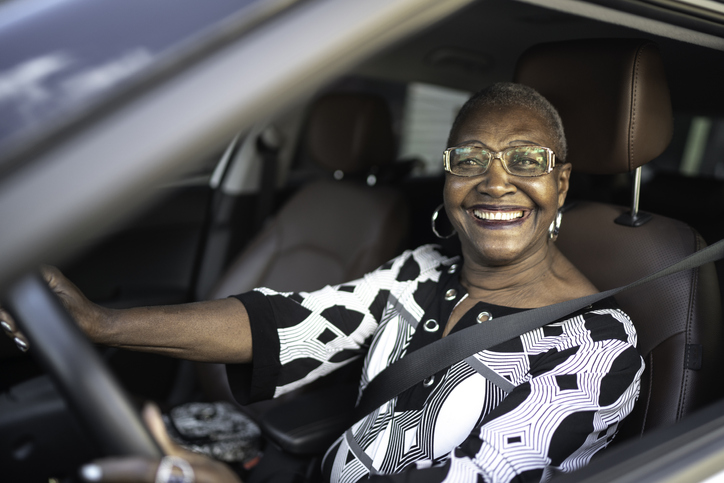More drivers than ever are older – 46.3 million licensed drivers were over 65 in 2019, according to the most current figures from the National Highway Traffic Safety Administration. The number of elderly drivers increased by 37% from 2010 to 2019, and with more adults living longer, those numbers are only going to grow. AAA says there will be more than 70 million people over age 65 by 2030, and 85%-90% of those senior citizens will be driving.
Older drivers are among the safest on the road, since they tend to wear their seatbelts, observe speed limits and don’t drink and drive, AAA says. But because of age-related vulnerability, older drivers have a higher rate of death from crashes, according to the U.S. Centers for Disease Control and Prevention.
If you’re an aging driver or care for one, there are ways to encourage safety on the road, what warning signs to watch for in seniors, and how to know when it’s time to give up the keys.
How Seniors Can Stay Safe On the Road
There are measures senior drivers can take to maximize their safety on the road. The CDC offers these tips:
- Always wear your seat belt
- Avoid distractions in your car, such as eating, listening to a loud radio, or using your phone
- Check with your doctor to discuss any medical issues or medications that can affect your driving
- Drive during daylight and in good weather when possible
- Look for safer routes with easy parking and well-lit streets
- Have your eyes checked by an eye doctor at least once a year
- Leave a sufficient following distance between your car and the car in front of you
- Never drive impaired by alcohol, drugs, or medicines
- Plan your route before you drive
Both AAA and AARP offer pages with more articles on safe driving for older adults.
When Should a Senior Stop Driving?
There may come a time when it’s best for aging drivers to surrender the keys. There are things seniors and caregivers can look for that might indicate that a change is needed.
What Are Some Warning Signs for Senior Drivers?
The physical effects of aging can be a barrier to safe driving. Eyesight problems, hearing problems, limited range of motion, illnesses and medications can all be a factor for older drivers and safety.
The NHTSA lists these warning signs to for seniors and their caregivers to monitor:
- Accelerating suddenly without reason
- Backing up after missing an exit or turn
- Braking or stopping abruptly without cause
- Coasting to a near stop amid moving traffic
- Difficulty reacting quickly or processing multiple stimuli
- Drifting into other lanes
- Driving significantly slower than the posted speed limit or general speed of other vehicles
- Getting lost or disoriented easily, even in familiar places
- Growing confusion while driving in traffic
- Higher levels of anxiety while driving
- Ignoring or missing stop signs and traffic signals
- Increasing dents and scrapes on their car or on objects where they park, such as curbs and garage doors
- Increasing number of close-call and near-miss incidents
- Making sudden lane changes
- Neglecting to use turn signals or forgetting to turn signals off
- Pressing simultaneously on the brake and accelerator pedals while driving
- Problems with back or neck flexibility and turning to see traffic or hazards around the car
- Receiving more than one traffic citation or warning in the past two years
- Straddling lanes
- Struggling to see pedestrians, objects and other vehicles
If these signs are present, it’s time to evaluate whether the senior should still drive.
How To Have the Talk About About Driving
Increasing difficulty driving doesn’t automatically mean it’s time to stop driving. There are a number of things seniors can do, including enrolling in a senior driving course to improve or refresh their skills.
If caregivers need to have a conversation with seniors about their diving, focus on driving skills, not age. Seniors need to know this is not about them getting older. Come alongside the senior to understand their feelings, whether they get angry, defensive, hurt or withdrawn.
The NHTSA advises these steps:
- Collect information. Note specific concerns about the person’s driving, such as incidents listed above
- Develop a plan. Convey your concerns to the driver, help them identify strategies for safer driving, and show them how to access and use alternative transportation
- Follow through on the plan. Make sure they understand this is for their safety, and the safety of other drivers
For seniors who may need to give up driving, make sure they know there are alternative transportation options available to them, such as call-ride services, community transportation, ride-share services, and more.
Live Safely at a Senior Lifestyle Community
Senior Lifestyle communities provide transportation to appointments and shopping, along with other needs. You can safely travel without worrying about driving.
Find out more about the amenities and programs available at a Senior Lifestyle community by contacting us today.

